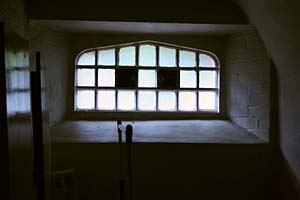
The City of Exeter Bridewell
Including the Guildhall
Page updated
8 August 2009
Return to Public Services
The City of Exeter's original Bridewell for criminals was located in one of the towers of the old Southgate while debtors were held in cells over the archway, giving them a fine view up South Street. The term Bridewell was adopted from the Bridewell Palace in London, a 16th century prison. The term 'living on a shoestring' comes from the habit of the prisoners in the Southgate lowering shoestrings from their cells, for friends to tie food and other commodities to them. The last prisoner to be executed by the city of Exeter in 1818, Samuel Holmyard, was held at the Southgate before he was taken on a cart to the Magdalen Road drop to meet his maker. It is worth mentioning that some recent histories of Exeter state that the flag pole outside the Rougemont Hotel was the site of the gallows at the Bridewell. I have found no evidence that executions took place here, and that all City of Exeter executions after 1818 were held at the Devon County Prison, above.
The old prison was closed in 1819 when the mediaeval Southgate was demolished to be replaced by the 'House of Correction', designed with a three wing radial design by Cornish, containing the central building, governor's quarters, infirmary and chapel, located on the site of the present Rougemont Hotel, in June 1819. Built for fifty prisoners, it had twenty single night-cells and separate housing for debtors. The prison had eight classes of prisoner - there were quarters for master and commoner debtors, two classes for female prisoners, and four classes for convicted and untried male prisoners. Each class had a day-room and exercise yard. The cells contained iron-bedsteads and the inmates were supplied with three blankets and a rug in the winter and two blankets in summer.
Even the chapel was segregated into classes with a chaplain attending every Sunday. They prided themselves in providing bibles, prayer-books and religious tracts. Each prisoner had an allowance of a pound and a half of white bread per day and ten pounds of potatoes per week.
Prisoners were expected to work the treadmill, which was used to beat hemp, probably for rope making. The treadmill had been largely constructed by one of the inmates. Female prisoners were engaged in washing, mending clothes and knitting stockings for the charity school in Exeter. Inside the outer wall, surrounding the prison complex was a garden.
The first Governor was Mr Gully from 1819 until his death in 1830, whereupon his son Mr J Gully was appointed, to remain in charge until the prison was closed in 1863. It was demolished and in 1877 construction on the Rougemont commenced.
The first two prisoners to enter the new prison were debtors, with one a trader from the High Street. They were immediately followed by prisoners from the Southgate Bridewell who were walked up South Street, down North Street and up Northernhay Street to their new quarters. Those who were on foot passed along Maddock's Row and through the archway cut in the city wall in 1771.
The escape
There was one attempt at escape from the prison by an inmate named McCarthy who was a tailor by trade. There had been rumours of an attempt at escape at the Sunday morning service for the prisoners and extra police were on duty in the prison that evening, out of site of the prisoners. The warder did his last round as usual that night, and McCarthy appeared to be asleep. Once the warder had passed, McCarthy used an old spoon to cut through a panel in the door and escaped his cell, taking with him a bakers jacket and cap he had secretly made, along with a bag for a brick and ropes made of blankets. He managed to reach the exercise yard, where he threw the bag containing the brick over the wall which was attached to his makeshift rope and started to climb the wall.
Warder Guppy's wife happened to see him and gave out an alarm that a prisoner was attempting an escape. The police rushed to the wall and one grabbed hold of the man's legs, pulling him back down, to be hurriedly locked back in a cell. He was later sentenced to twenty years' transportation for breaking into the house of Mr Windeat, the draper, which was close to the police station.
The Guildhall
The Guildhall was also used to house prisoners with a cellar beneath the building which dates from the 14th-century used as a prison and referred to as the 'pytt of the Guyldhall'. The rear of the Guildhall in Waterbeer Street has windows for the female cells on the ground floor. Built in the 16th-century, the cells were last used in 1887.
Source - Reminiscences of Exeter Fifty Years Since by James Cossin, Penny Illustrated 1903, Portrait of Exeter by Brian Little, Two Thousand Years in Exeter by W G Hoskins, Cowick Street Conservation Area Appraisal and Management Plan, various websites about John Lee. GENUKI Exeter history website, quote from Vincent's Guide to Exeter 1884, and Tony Lethbridge.
 City of Exeter Bridewell by
George Townsend - now the site of the Rougemont Hotel.
City of Exeter Bridewell by
George Townsend - now the site of the Rougemont Hotel.
 A cell window from the inside, at the Guildhall.
A cell window from the inside, at the Guildhall.
│ Top of Page │